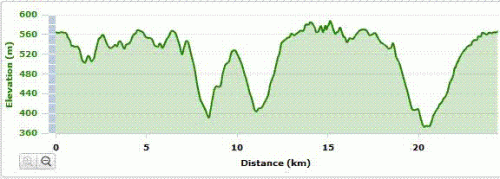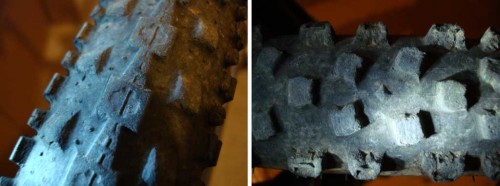
Last weekend I raced in the Foxy 1000, a 100km enduro race with the claim to fame of 1000m of climbing in each of the four laps. The race covers much of the single track and fire roads at Fox Creek, and if you’re good at math(s) then you’ll have noted that it climbs over 4000m/13,000ft. The 2010 course map is below, or go to the Garmin Connect site for an interactive map and elevation.

While the course map and elevation plot do provide good insight into the course, they do not show some important details. The first half of the course was far more technical and difficult than the second. The lap starts out with long, steep climbs, and includes downhill runs that were technical and in pretty rough shape after a very wet winter. The second half on the course had a very fast fire road descent where I hit just under 60kph, though I’m sure others were much faster. The elevation plot makes the last climb look a lot worse than it felt. Despite the apparent grade, it was decidedly relaxing compared to the earlier climbs.
There were several classes ranging from the full four-lap 100km down to 75, 50 and 25km options. I decided to take my chances in the 100km ‘Men’s Open Grade’. There were a total of 12 in my class, and a total of 47 racing.
My first lap went well. The climbs were nice, and the downhills were fast and fun. Looking at the results, I completed the first lap in the eighth fastest time. The second lap also went well, but by the third lap the fatigue of the downhill was taking its toll. My second and third laps were much slower than the first, which isn’t so surprising. At the end of my thrid lap my time was six hours forty-five minutes, and the prospect of another run down the downhill didn’t seem appealing. Instead, I opted to finish at 75km and watch the rest of the race with some chips and beer.

Overall, I’m happy with my performance. My official time for my three laps and 75km was 6:45:16, with my computer showing a total ride time of 6:29:37. The 15 minute discrepancy would be for a water bottle swap after the first lap, and a brief lunch break (half a PB&J and a banana) after the second lap. Full results are available on the official Foxy 1000 site. Next year my goal will certainly be to finish all four laps.
Equipment Updates: The Specialized MTB Comp shoes were great. In stark contrast to the old Shimano shoes, I had zero foot pain and am quite happy. As for the bike, the Eriksen worked flawlessly the entire 75km. The drivetrain didn’t have a single fault and the brakes didn’t complain. From a mechanical perspective it was an uneventful race. Though, I will have to say that I replaced the rear derailleur cable and housing, replaced the brake pads, removed and lubed the crank/bb and spent a significant amount of time aligning the chain keeper prior to the race.

For those who are interested in tires/tyres, I used a ~50% worn Maxxis Crossmark 2.1 on the back inflated to 28psi and a fairly chewed-up Hutchinson Toro 2.15 on the front inflated to ~25psi. Neither tire/tyre is “tubeless”, but both are being used as tubeless with Stan’s sealant. The Toro was probably overkill for the course, but it worked well. The Crossmark climbed very well despite significant wear in the center on the tread– I’ve been riding on the road from home, through the city, and up into the hills a lot recently.
I didn’t have any flats or other issues with the tires/tyres, though I did bottom-out the rear tire/tyre once on the first downhill. Having had my share of pinch flats in the past, this impact certainly felt like it would have resulted in one had I been using tubes. +1 for tubeless.
Thanks and photo credits to FBQ for the race photos. See more race photos of the Foxy 1000.






